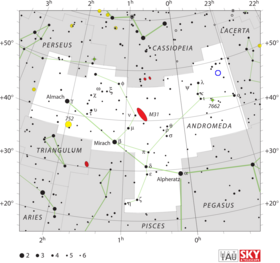OS Andromedae
| Observation data EpochJ2000EquinoxJ2000 | |
|---|---|
| Constellation | Andromeda |
| Right ascension | 23h12m05.936s[1] |
| Declination | +47° 28′ 19.49″[1] |
| Apparent magnitude(V) | 6.3 - 18.0[2] |
| Characteristics | |
| Variable type | Nova[3] |
| Astrometry | |
| Proper motion(μ) | RA:−1.944±0.211[1]mas/yr Dec.:−0.368±0.204[1]mas/yr |
| Parallax(π) | 0.1378 ± 0.1377mas[1] |
| Distance | 3298+1670 −524[3]pc |
| Absolute magnitude(MV) | −7.56[4]-+3.3[5] |
| Details | |
| White dwarf | |
| Mass | 1.0[4]M☉ |
| Luminosity | 84,000 (max)[4]L☉ |
| Donor star | |
| Other designations | |
| Database references | |
| SIMBAD | data |

OS Andromedae,known also asNova Andromedae 1986,is aclassical novathat appeared in the constellationAndromedaduring 1986. It was discovered at 10:34 UT on 5 December 1986 by Mitsuri Suzuki, a 28-year-old school teacher living inEna,Japan. He photographed the portion of theMilky Waythat passes through northern Andromeda with a 200-mm telephoto lens, and found the nova when itsapparent magnitudewas 8.0. Two days later it reached a peakapparent visual magnitudeof 6.3.[7][5]
OS Andromedae had an intrinsic decay time (for a three magnitude drop) of 25 days, making it a "fast" nova. A sudden decrease in visual andultravioletlight, which occurred 30 days after the peak, was due to dust formation during the nova event. The mass of the white dwarf has been estimated to be 1.05M☉[8]and it was estimated that 3.5×10−5M☉was ejected during the event. The chemical composition is typical of a CO nova.[4]At the estimated distance of 4.2 kiloparsec,itsabsolute magnitudeat the peak was -7.56.[4]
References
[edit]- ^abcdeBrown, A. G. A.;et al. (Gaia collaboration) (August 2018)."GaiaData Release 2: Summary of the contents and survey properties ".Astronomy & Astrophysics.616.A1.arXiv:1804.09365.Bibcode:2018A&A...616A...1G.doi:10.1051/0004-6361/201833051.Gaia DR2 record for this sourceatVizieR.
- ^N. N. Samus; O. V. Durlevich; et al."OS And database entry".Combined General Catalog of Variable Stars(2017 ed.).CDS.Retrieved2018-11-12.
- ^abcSchaefer, Bradley E. (2018)."The distances to Novae as seen by Gaia".Monthly Notices of the Royal Astronomical Society.481(3): 3033–3051.arXiv:1809.00180.Bibcode:2018MNRAS.481.3033S.doi:10.1093/mnras/sty2388.S2CID118925493.
- ^abcdeKato, M.; Hachisu, I. (March 2007). "Modeling of the Super-Eddington Phase for Classical Novae: Five IUE Novae".The Astrophysical Journal.657(2): 1004–1012.arXiv:astro-ph/0611594.Bibcode:2007ApJ...657.1004K.doi:10.1086/511058.S2CID118993608.
- ^abHachisu, Izumi; Kato, Mariko (2014). "The UBV Color Evolution of Classical Novae. I. Nova-giant Sequence in the Color-Color Diagram".The Astrophysical Journal.785(2): 97.arXiv:1401.7113.Bibcode:2014ApJ...785...97H.doi:10.1088/0004-637X/785/2/97.S2CID118536980.
- ^"OS Andromedae".SIMBAD.Centre de données astronomiques de Strasbourg.Retrieved2019-08-21.
- ^"OS And (Nova Andromedae 1986)".aavso.org.AAVSO.Retrieved2 January2021.
- ^Hachisu, Izumi; Kato, Mariko (June 2019)."A Light-curve Analysis of 32 Recent Galactic Novae: Distances and White Dwarf Masses".The Astrophysical Journal Supplement Series.242(2): 18.arXiv:1905.10655.Bibcode:2019ApJS..242...18H.doi:10.3847/1538-4365/ab1b43.S2CID166228785.

